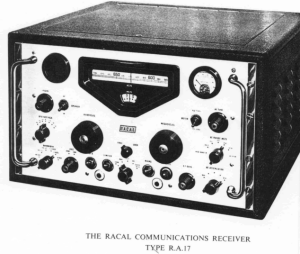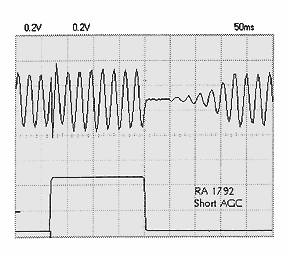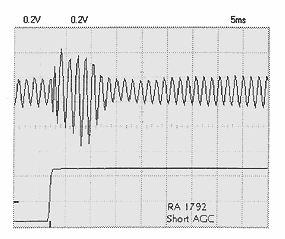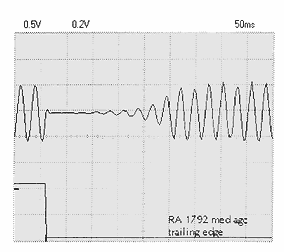The Racal RA17
We love our boat-anchors, but by the late 1940's it would need a sea-change in design to improve the performance of HF communications receivers.

Even the best were lacking in frequency accuracy, stability, image rejection, and IF selectivity.
The answer was the multiple conversion superhet. Build a good, stable receiver that tunes a limited frequency range at a medium frequency of 2-3 MHz. Use a crystal controlled converter as a front end to select the frequency band of interest. You'll need a separate converter crystal for each 1-MHz band tuned.
The Collins 51J did it this way, tuning 0.5 to 30.5 MHz in thirty 1 MHz bands. Very technical but compromised, it does this with only 10 crystals.
Raymond Brown and George Calder Cunningham established Racal Ltd. in 1950, forming Racal Engineering Ltd a year later. Racal hoped to get the rights to make the new Collins 51-J HF communications receiver, landing a contract with the Royal Navy for the supply of 200 receivers using British components.
Collins insisted that only US components be used and after a visit to Racal's primitive start-up at Isleworth, Collins pulled out. Racal had to produce a receiver with the same spec as the Collins to meet their contract.
Looping the Loop
Over in South Africa, Dr. Trevor Wadley was developing a receiver based on a very accurate frequency control scheme he had developed for use in test equipment. Racal and Wadley got together resulting in one of the world's great receivers.
Design work on the RA17 started in late 1954 and production continued until 1967. It uses 22 tubes plus a rectifier. Tuning range is 0.5 to 30 MHz in 30 1MHz bands.
Big Knobs
The title is for Google's benefit. The front panel is lead by the Collins-inspired tuning dial bezel and two large tuning knobs. The MEGACYCLES knob is the band selector. It tunes 0 to 29 MHz in a turn and a half with no detents. Tune the frequency you want in the middle of the small window and peak the noise or signal.
The smooth KILOCYCLES knob does the tuning across the selected 1MHz band. It controls a 6-foot piece of 35mm film that serves as the readout, resolving to twenty 1 kHz divisions per inch so the 0.5 to 30MHz tuning range is effectively spread across 145 feet.
The antenna input is low-pass filtered, amplified, and up-converted to a first IF of 40MHz. Up-conversion gives you an extremely high degree of image rejection because the image is separate from the desired signal by 80 MHz.
After passing through a 1 MHz wide filter at 40 MHz, the signals are down converted to a tuneable IF of 2-3 MHz. The signals are then converted to a 100 kHz final IF for amplification, filtering, and detection.
The local oscillator signal for the first mixer is a fairly conventional variable-frequency oscillator. Because of the up-conversion scheme, this can tune the entire 29MHz range by providing an injection signal in the range of 40.5 to 69.5 MHz. In a conventional design, such a free-running oscillator at that frequency would be hopelessly unstable.
Now the magic of the Wadley error-cancelling loop comes in. A harmonic generator and low-pass filter driven by a 1MHz crystal oscillator creates a range of frequencies at 1MHz intervals from 1 to 32 MHz.
Mixer M4 translates this range upward in frequency by an amount determined by the signal from the VFO. If the VFO is tuned within 150 kHz of an even half megahertz, one of the frequencies in the range will pass through the 37.5 MHz filter and be applied to mixer M2 converting the desired signal from the 40 MHz first IF down to the 2-3 MHz tuneable second IF.
The net accuracy of the up-conversion-down-conversion process is established by the offset between the first and second local oscillator signals and this will always be an exact multiple of 1MHz as set by the crystal oscillator. And this wide range of tuning is accomplished with a one variable capacitor and one oscillator coil.
John Wilson Looks Back On The RACAL RA17
The most vocal supporter of the RA17 is undoubtedly Michael O'Beirne and he has advocated its cause very effectively.
The major point which Michael makes, and with which I totally agree, is that a good RA17 can be very good, but after such a long production run there are receivers around which are showing signs of incipient electronic arthritis and which need to be viewed with some caution - much the same as the very shiny 40 year old car which may hide dreadful secrets under its bonnet or back axle. Should you succumb to the desire to have an RA17 or any other elderly receiver, please keep in mind that skilled assistance will almost certainly be needed, supported by a battery of quite expensive test equipment and the knowledge of how to use it.
Michael and I take delight in restoration of these elderly beauties just for the feeling of achievement when it all comes together at the end, but it would be impossible to place a commercial value on such restoration, particularly considering Michael's normal rates of pay at the top end of the legal profession, or my position running a UKAS accredited EMC test house. We do it for the love of the hobby alone. If you are the same, by all means start collecting and restoring.
Staying With The Racal Theme
I have been fortunate to have a second loan of an RA1792 and am even more convinced that this was an outstanding piece of technology in its time, and a receiver that will show you what real h.f. performance and ergonomic design can mean. However, the stricture regarding support service applies with even more force should you acquire an RA1792 with hidden problems, and you had better be equipped with some digital data analysis capability should there be something amiss in the processor controlled functions. Bearing in mind the poor results shown by the RA17 a.g.c. system, I took the time to carry out the same tests on the RA1792, and there is a world of difference to report.
There are three a.g.c. speeds selectable from the keypad, labelled 'short', 'med.' and 'long', but at first use they are very different. The short and medium decay characteristics are very similar, with a fast(ish) attack time and well controlled restoration of full gain, but when Racal use the term 'long', they mean very long indeed.
I was surprised to find when I went to locate my original review of the RA1792 that it was way back in the previous century (actually September 1998), prior to my using the a.g.c. tests I now carry out as a matter of course, so I thought I should check and see exactly how it compared to other receivers tested more recently.
Look at Fig. 1 and see the RA1792 audio performance using short a.g.c. decay, with near perfect gain control and smooth recovery after about 100ms of delay. However, note the 'spike' at the onset of the input burst which turned out to be the now familiar overload as shown in Fig. 2, the surprise being that the RA1792 behaves just like a classic valve receiver such as the 51S-1, rather than producing the usual semiconductor 'click'.
Fig. 3 shows the recovery time in the 'med.' a.g.c. setting, with about 200ms delay before the smooth gain restoration. In the 'long' a.g.c. setting Racal sneakily introduce a proper 'hang' system which keeps gain down for about 1.5s after the incoming signal ends before restoration at the same rate as seen in the 'med' setting.
In real on-the-air action this long setting is just perfect for s.s.b. listening and is probably nicer than the Collins 51S-1 in this regard, hard though that is for me to confess. Racal certainly redeemed themselves after the disastrous a.g.c. in the RA17.

Fig. 1: The RA1792 audio performance using short a.g.c. decay.

Fig. 2: RA1792 'spike' at the onset of the input burst.

Fig. 3: RA1792 recovery time in the 'med.' a.g.c. setting, with about 200ms delay.
Happy listening
John Wilson's article featured in the April 2001 Airband Special edition of Short Wave Magazine and is reproduced here by kind permission of Short Wave Magazine and PW Publishing Ltd
Going Through Barlow-Wadley Loops
I did a write-up on the XCR-30 some time ago, included in a general article on the various implementations of the Wadley drift cancelling loop, and told the story of an honourable Japanese company who had contracted with Peter Drake to produce a Wadley loop receiver exclusively for Drake under the model type SSR-1.
No sooner was it in production than the same honourable company sold the same receiver to Lowe Electronics in a slightly different enclosure style and we marketed it as the Lowe SRX-30.
Then, to mount a third Pearl Harbor they went and sold our exclusive receiver to a German company who marketed it under the title Century 21. Happy Days.
Having said all that, the Barlow-Wadley, made in South Africa, was quite a receiver and works well as a portable World Band radio.
I know that my old friend Larry Magne may not agree with me but the XCR-30 is remarkably free from unwanted spurious signals and mysterious wandering heterodynes, and once you have become accustomed to tuning with vertical thumb wheels it's a good thing to have along on portable excursions.
You do have to have the digital sensitivity of an expert safe-cracker to get on frequency when receiving SSB, but at least it does it properly, and for a 1970s receiver it was indeed a landmark.
But you are right; a premium receiver it ain't - 73 John Wilson.